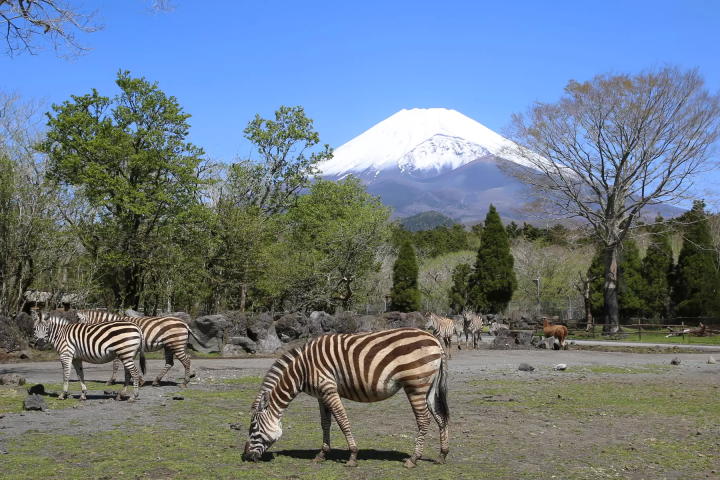Hakone Autumn Foliage: 10 Beautiful Fall Spots in 2025

Hakone is a popular hot spring resort close to Tokyo. Learn the best 10 autumn foliage spots in Hakone, including Choanji Temple, Hakone Tozan Railway, and Hakone Museum of Art.
Hakone's Beautiful Fall Foliage
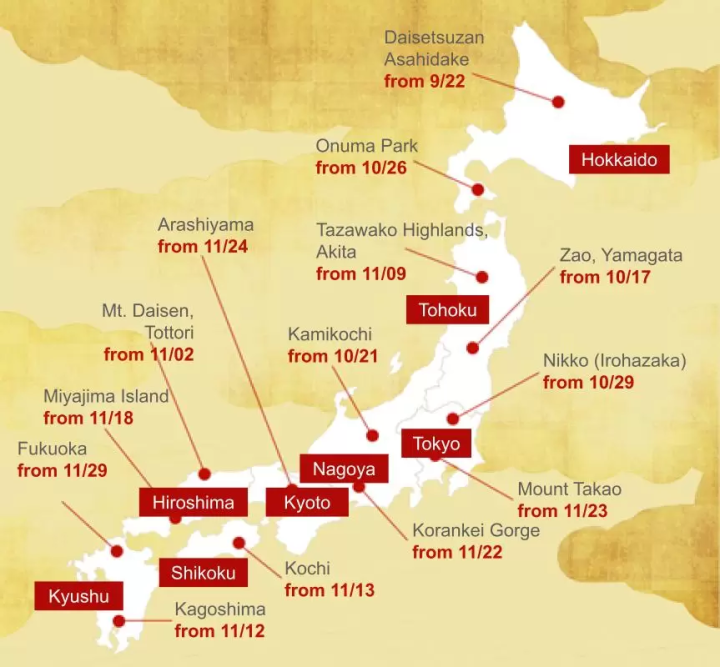
2025 fall foliage map based on information from Weathernews
Hakone is located in the western part of Kanagawa Prefecture. This hot spring resort town can be easily reached from Tokyo's Shinjuku Station.
Many visitors come to soak in hot springs and enjoy outdoor excursions, including mountain climbing. However, a large number of people visit Hakone from October to mid-November for the fall foliage.
This article will introduce Hakone's best 10 fall foliage spots with fantastic views showcasing this striking seasonal display.
10 Fall Foliage Spots in Hakone
1. Hakone Gora Park
2. Hakone Museum of Art
3. Lake Ashi
4. Choanji Temple
5. Hakone Tozan Railway
6. Sengokuhara Susuki Grass Fields
7. Pola Museum of Art
8. Hakone Open Air Museum
9. Hakone Ropeway
10. Daiyuzan Saijoji Temple
Read also
1. Hakone Gora Park

Picture courtesy of the Hakone Gora Tourist Association
Gora Park is located in Gora, one of Hakone's premium hot springs areas. It was completed in 1914 as Japan's first French-style park. Built on a slope, trees, and flowers surround the Western-style recreation ground.
There are various types of flowers blooming on the premises. Many tourists flock to Gora Park to enjoy roses that bloom during this time of the year alongside the autumn leaves.
Hotels near Hakone Gora Park
2. Hakone Museum of Art
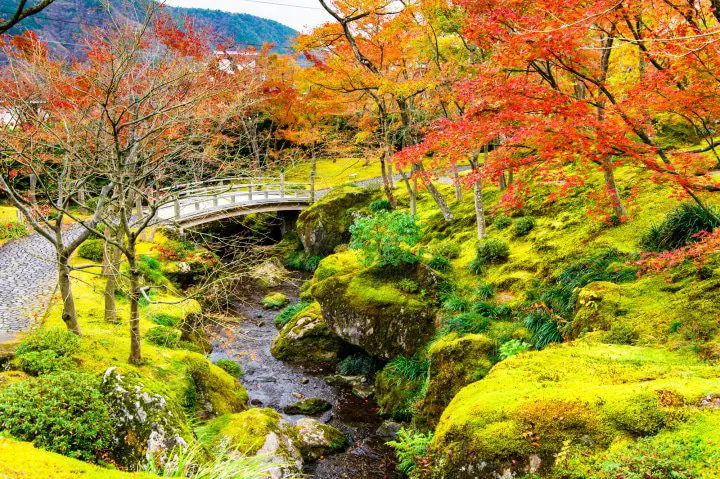
Photo by Pixta
The autumn leaves at the Hakone Museum of Art, the oldest museum in the town, is found in its 1,900-square-meter moss garden.

Photo by Pixta
Approximately 130 types of moss and 200 trees gradually turn red and yellow when fall rolls around. Visitors can walk along the promenade surrounded by lush nature. The contrast between the green moss and autumn leaves is a unique sight!
After enjoying the moss garden and foliage, why not visit the museum as an additional treat?
Hotels near Hakone Museum of Art
3. Lake Ashi

Photo by Pixta
Lake Ashi, the largest lake in Kanagawa Prefecture, offers visitors views of Mt. Fuji with the backdrop of the autumn leaves. You can marvel at this vast body of water coupled with the surrounding foliage turning red and yellow hues. It is truly an astonishing sight! On clear days, Mt. Fuji is visible in the distance as well.
Visitors can also enjoy the view from pirate-themed sightseeing boats, which depart from four ports at Lake Ashi.
Hotels near Lake Ashi
4. Choanji Temple
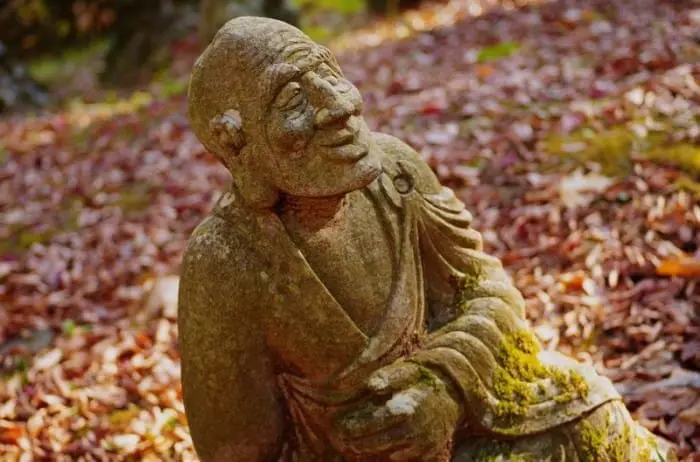
Choanji is a Buddhist temple built about 700 years ago. The statues of the Gohyaku Rakan, the 500 disciples of Buddha who attained nirvana, stand quietly in a nearby bamboo thicket. The details of each statue are different, so be sure to check them out carefully! It is quite refreshing to see these Buddhist stone statues displaying different emotions.
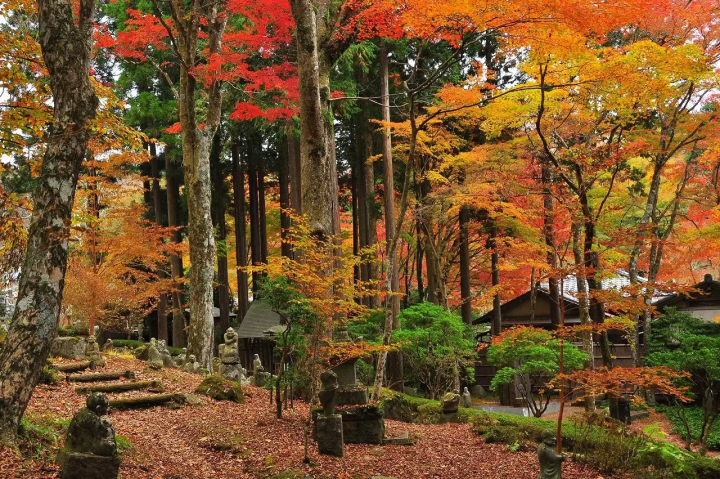
Photo by Pixta
Choanji Temple is a quiet area away from Hakone's busy central district. It makes for a relaxing afternoon filled with nature and exploring serene temples.
5. Hakone Tozan Railway
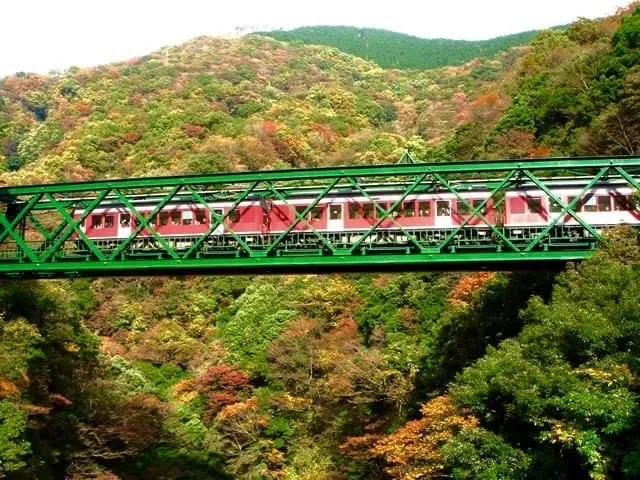
Picture courtesy of the Hakone Tozan Train
Hakone Tozan Railway operates about a two-kilometer distance between Odawara Station and Gora Station. The cars zig-zag their way up the steep hill. This is also why the railway is named "tozan," which means "mountain climbing" in Japanese.
The Hayakawa Railway Bridge (located between Tonosawa Station and Deyama Signal Station), also known as the Deyama Railway Bridge, offers a spectacular view for riders. The cars stop briefly at this bridge so passengers can enjoy the autumn leaves.
While heading up the mountainous slope, watching the foliage up close on top of a railway bridge surrounded by seasonal nature is incredibly serene. This unique experience is exclusively offered on a ride along the Hakone Tozan Railway.
Business Time
First Train from Odawara: Everyday 5:33
Last Train from Gora: Everyday 22:41
Fixed holidays
Open 365 days a year
WiFi
Not Available
Accepted Credit Cards
Not Available
Languages
Japanese, English, Chinese, Korean
Menu/Pamphlets in Other Languages
Japanese, English, Chinese, Korean
Access
Visitors can switch trains at Odawara Station (JR Tokaido Line)
Telephone number
+81-46-532-6821 (Hakone Tozan Railway General Administration)
Website
http://hakone-tozan.co.jp/en/
6. Sengokuhara Susuki Grass Fields
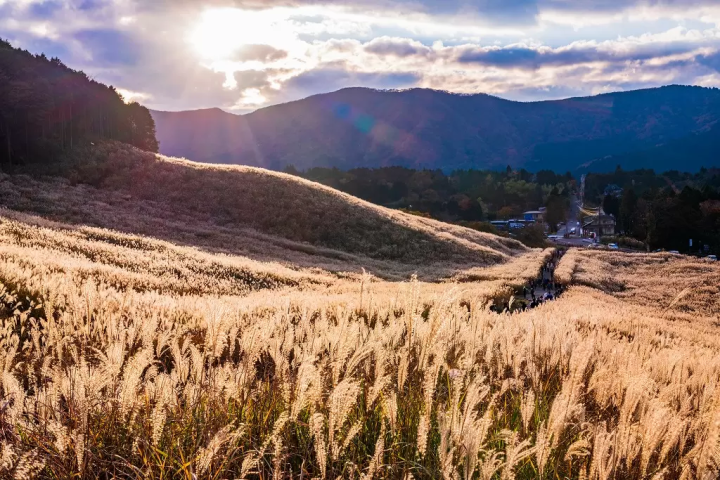
Photo by Pixta
The Sengokuhara Pampas Grass Fields in Hakone is a breathtaking landscape renowned for its expansive fields of shimmering silver grass that sway gently in the breeze.
Each year, from late September to early November, the vibrant green landscape transforms into a lush tapestry of elegant silver pampas grass, making it a must-visit destination during the autumn season.
Easily accessible in just 30 minutes from Hakone-Yumoto Station, this unique natural attraction sprawls up the west hillside of Mount Hakone, guiding visitors along a stunning walking trail that offers incredible panoramic views.
The combination of the flowing grass and the atmospheric scenery creates a truly special destination for nature lovers and photographers alike!
Hotels near Sengokuhara Susuki Fields
7. Pola Museum of Art
The Pola Museum of Art, located in Hakone National Park, is a captivating destination that seamlessly combines art and nature. Surrounded by lush forests, this museum houses an impressive collection of approximately 10,000 artworks from modern to contemporary, including pieces by renowned artists such as Monet and Picasso.
The architectural design of the museum harmonizes beautifully with its natural surroundings, featuring large windows that provide stunning views of the changing seasons. During autumn, the area transforms into a vibrant palette of red, orange, and gold leaves, enhancing the museum's scenic beauty.
The museum’s modern art coexists with the area’s breathtaking landscape, highlighting the distinctive beauty of both natural and artistic invention. In addition to its exquisite art collection, the museum has a beautiful cafe where visitors can unwind while enjoying the natural surroundings.
By spending a few hours here, you can immerse yourself in both the spectacular autumn foliage and the world of exquisite art, creating a truly enriching experience.
Hotels near Pola Museum of Art
8. Hakone Open Air Museum
The Hakone Open Air Museum is a remarkable creative hub that beautifully merges art and nature.
Set against a backdrop of lush mountains, this unique outdoor museum features a vast collection of around 120 outdoor sculptures by renowned artists such as Niki de Saint Phalle, Henry Moore, and Taro Okamoto, all thoughtfully placed in harmony with the surrounding landscape.
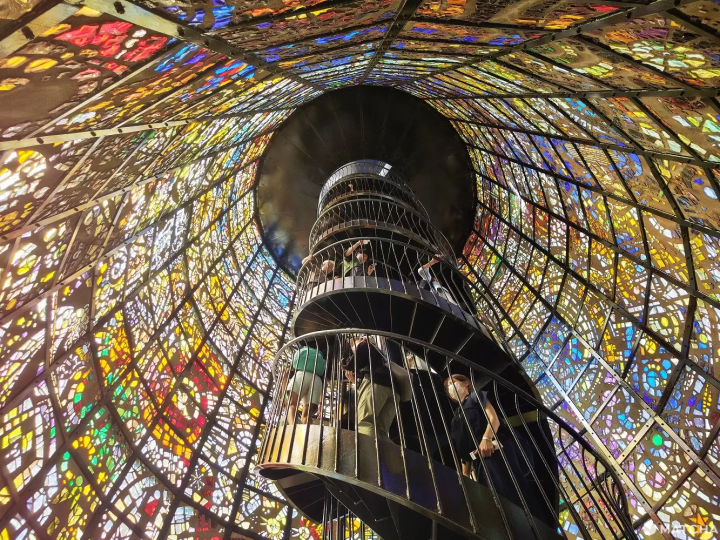
One of the many highlights of the museum is the Symphonic Sculpture by artist Gabriel Loire, which is a striking large spiral staircase with walls of colorful stained glass that filter sunlight.
In autumn, the museum's grounds are painted with a breathtaking display of vivid red, orange, and gold leaves, enhancing the beauty of both the artworks and the natural scenery.
In addition to the stunning foliage, the museum offers indoor galleries showcasing a diverse range of modern art, making it a haven for art enthusiasts. Visitors can also enjoy vibrant seasonal events and workshops that enhance the experience.
Hotels near The Hakone Open-Air Museum
9. Hakone Ropeway
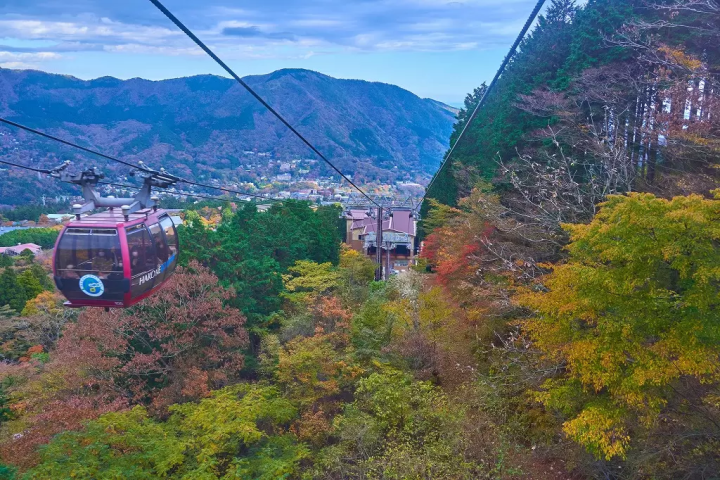
Photo by Pixta
The Hakone Ropeway offers a breathtaking aerial journey that connects Lake Ashi to the Owakudani volcanic area and Sounzan Station. Once ascending to 130 meters above ground, passengers are treated to panoramic views of the surrounding mountains and lush valleys.
During autumn explorers can catch panoramic views of Hakone's landscape flourishing in incredible vivid red, orange, and gold foliage! The vibrant colors of the trees against the backdrop of landmarks such as Mount Fuji create an unforgettable scenic experience that draws visitors from around the world.
The entire journey takes approximately 45 minutes, with the ropeway stopping every 15 minutes at new locations and stations, allowing for incredible views at each turn. Along the way, visitors can see the smoldering Owakudani, also known as Hell Valley, known for its geothermal activity and famous black eggs boiled in hot springs, Mount Fuji, alongside the incredible views of Lake Ashi shimmering in the sun.
Easy and convenient, the ropeway is covered on the Hakone Freepass so make sure to book yours before visiting!
Book the Hakone Freepass (2 or 3 days)
10. Daiyuzan Saijoji Temple
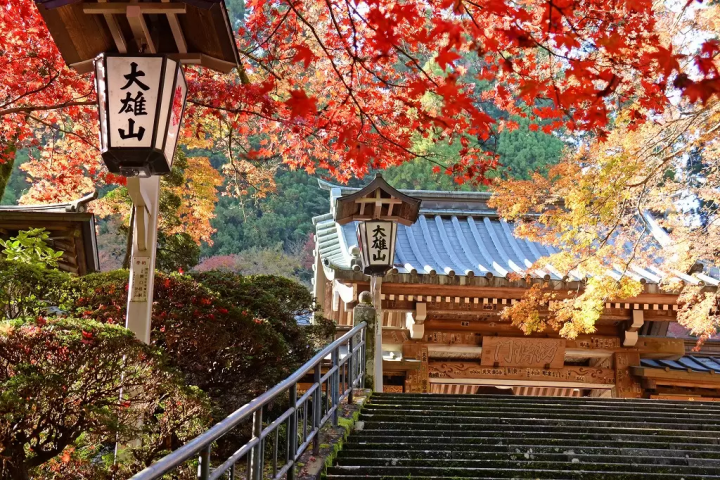
Photo by Pixta
Daiyuzan Saijoji Temple, located in the serene mountain forests of Hakone and just a 30-minute drive from Hakone Yumoto Station, offers a beautiful escape just two hours from Tokyo.
Built in 1394, this historic temple is surrounded by over 20,000 ancient cedar trees, creating a tranquil atmosphere ideal for reflection and connection with nature. In autumn, the temple grounds come alive with vibrant fall foliage, as rich reds and gold enhance the lush greenery and moss-covered stones. The soft sunlight filtering through the colorful leaves creates an ethereal ambiance, particularly stunning in the morning light.
Adding to the temple's allure is its cultural significance, steeped in legend with connections to the mythical tengu, creatures believed to bestow extraordinary powers. Visitors can marvel at the giant geta, and traditional wooden sandals associated with the tengu, adding a whimsical touch to this enchanting experience. The combination of autumn beauty and cultural poignancy makes Daiyuzan Saijoji Temple a must-visit destination.
FAQ
Where can I see autumn leaves in Hakone?
In Hakone, a renowned destination in Japan celebrated for its hot springs and natural beauty, several ideal spots offer enchanting views of autumn foliage, known as "koyo." Hakone Gora Park showcases a stunning array of trees displaying vibrant reds, oranges, and yellows, creating a picturesque backdrop for leisurely strolls. The Hakone Open-Air Museum blends captivating art installations with serene gardens, providing a unique setting to appreciate the seasonal transformation of leaves. Along the shores of Lake Ashi, visitors can admire the mountainside ablaze with autumn hues while cruising the tranquil waters. The Hakone Botanical Garden of Wetlands boasts diverse plant species, including colorful foliage that adds a vibrant touch to the landscape. Lastly, the Hakone Detached Palace Garden, nestled near the Hakone Museum of Art, features meticulously crafted Japanese gardens that come alive with autumnal brilliance, offering an immersive experience in the beauty of fall in Hakone.
What is the best time to visit Hakone?
Choosing the best time to visit Hakone involves considering the seasonal highlights and personal preferences. Spring, from March to May, presents cherry blossoms in full bloom, creating picturesque scenes around Lake Ashi and Hakone Park. Summer, spanning June to August, offers warm weather for outdoor activities like hiking and visiting the hot springs, although it tends to be crowded. Autumn, from September to November, showcases the stunning transformation of foliage into vibrant reds, oranges, and yellows, making it ideal for witnessing the colorful "koyo" season. In winter, from December to February, Hakone's onsens provide a relaxing retreat amidst potential snowfall, offering serene landscapes and tranquil experiences. To avoid crowds, visiting on weekdays or outside peak holiday seasons like Golden Week or New Year's can provide a quieter Hakone experience. Ultimately, the best time to visit Hakone depends on individual preferences, whether seeking cherry blossoms, autumn foliage, cozy winter retreats, or quieter moments amidst nature's seasonal beauty.
How many days in Hakone is enough?
The optimal number of days to spend in Hakone varies based on your itinerary and preferences. A single day allows for a glimpse of key attractions like the Hakone Open-Air Museum and Lake Ashi. Extending your visit to two days permits a more in-depth exploration, encompassing sites such as Owakudani and the Hakone Checkpoint Museum, along with leisurely onsen experiences. For a comprehensive and relaxed Hakone experience, consider dedicating three or more days. This timeframe enables deeper immersion, including multiple hot spring visits, hikes along scenic trails like the Hakone Old Tokaido Road, and potential excursions to nearby destinations such as the Fuji Five Lakes or Atami. Tailoring your Hakone trip duration to align with your interests ensures a fulfilling and enriching experience in this captivating region renowned for its natural beauty and cultural attractions.
Is Hakone colder than Tokyo?
In general, Hakone tends to be slightly cooler than Tokyo due to its higher elevation and mountainous terrain. The Hakone region, located in the Fuji-Hakone-Izu National Park, sits at an altitude of around 600 to 1,200 meters above sea level, compared to Tokyo's lower elevation. This difference in altitude contributes to cooler temperatures in Hakone, especially during the summer months.
During the winter season, Hakone can also experience colder temperatures compared to Tokyo, often resulting in the possibility of snowfall in Hakone while Tokyo remains snow-free. The variation in elevation and the proximity to the mountains contribute to Hakone's cooler climate, providing visitors with a refreshing and sometimes chilly escape from the urban heat of Tokyo, particularly during the hot summer months.
Is it worth staying overnight in Hakone?
Staying overnight in Hakone offers a serene and immersive experience filled with relaxation, scenic beauty, and cultural exploration. This picturesque area renowned for its hot springs and traditional ryokan provides a tranquil retreat, allowing visitors to unwind in onsens and enjoy the stunning vistas of Mt. Fuji, Lake Ashi, and the surrounding mountains. By spending the night, travelers can savor the area's attractions such as the Hakone Open-Air Museum and Hakone Shrine at a leisurely pace while avoiding the daytime crowds from Tokyo. Ultimately, a stay in Hakone is a chance to embrace the tranquility and traditional charm of this Japanese gem.
Enjoy the Best of Japan's Autumn in Hakone!
Although Hakone is famous for its hot springs, there are countless spots to marvel at the autumn leaves in addition to the 10 places mentioned above. With its proximity to Tokyo, why not plan a day trip to Hakone for a one-of-a-kind experience in the fall?
Read also
1995年生まれで東京外国語大学生です。言語を学ぶことが好きで、大学ではフランス語と英語、あと中国語を学んでいます。








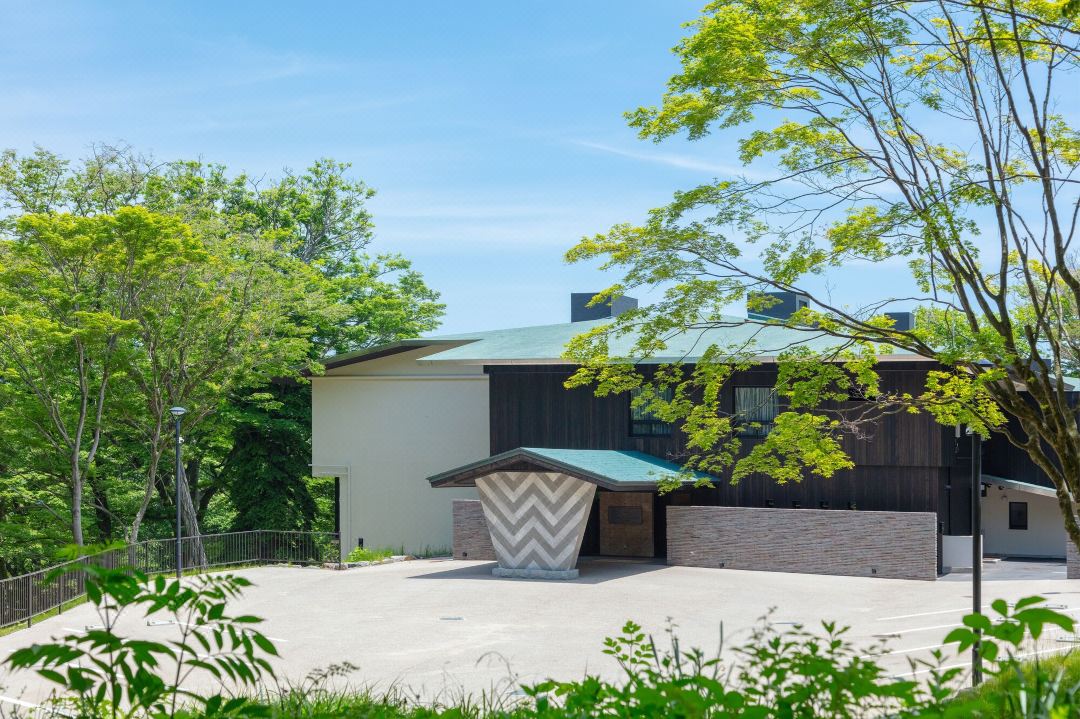

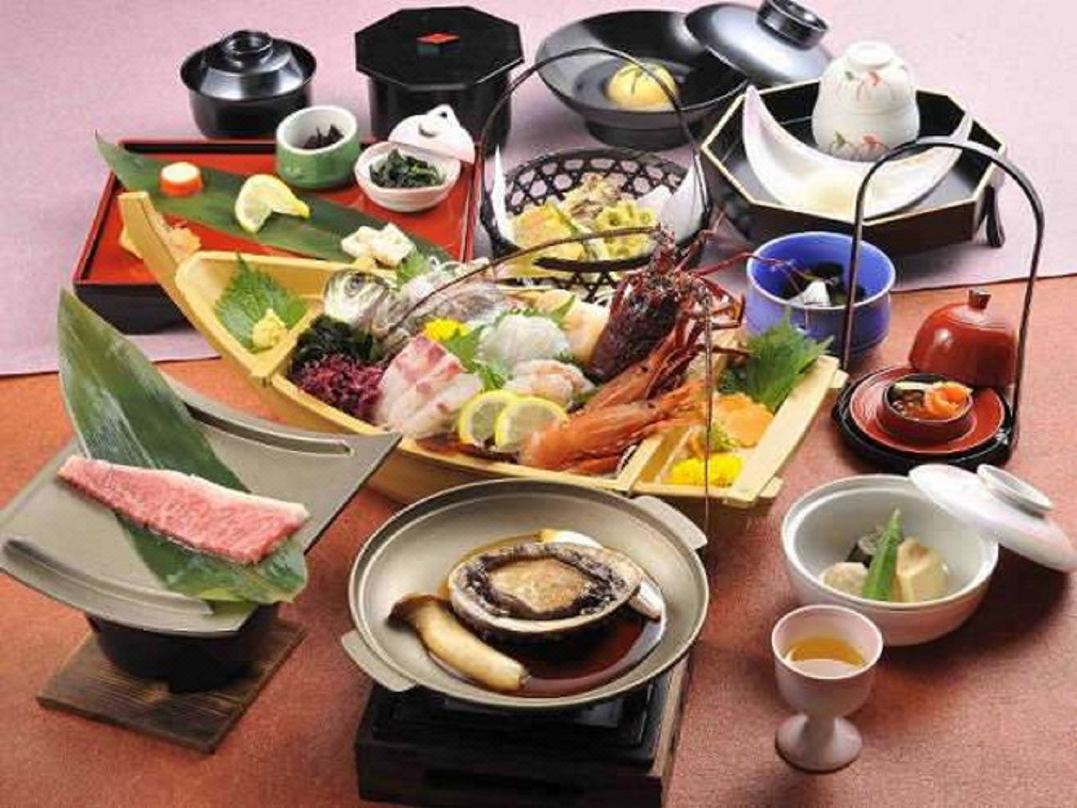
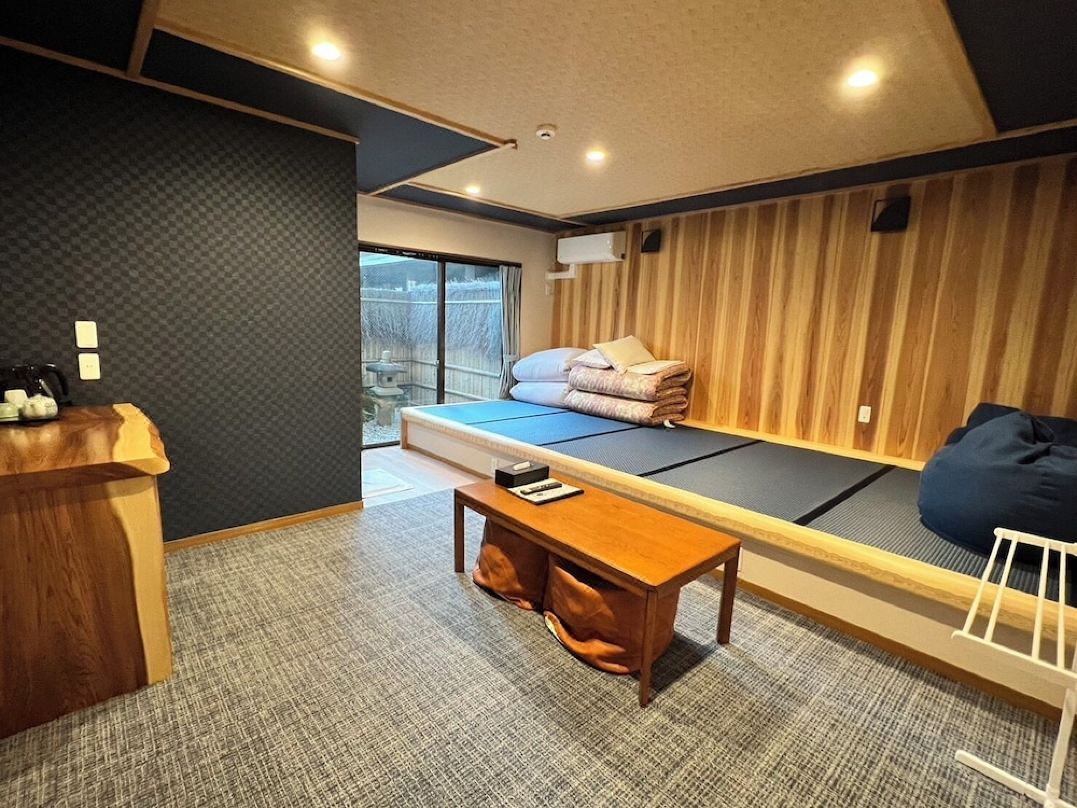


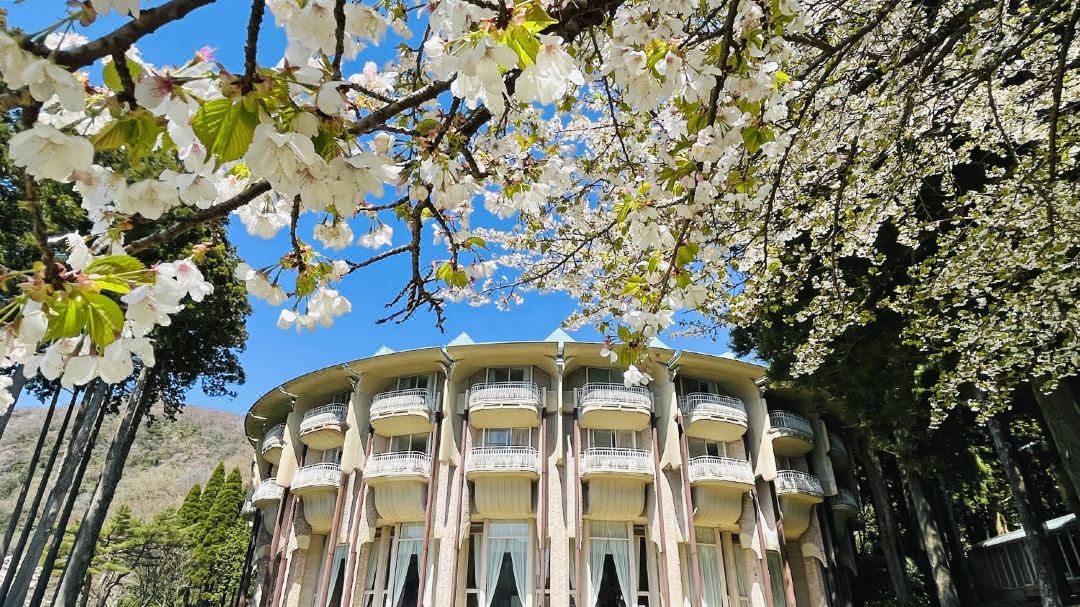

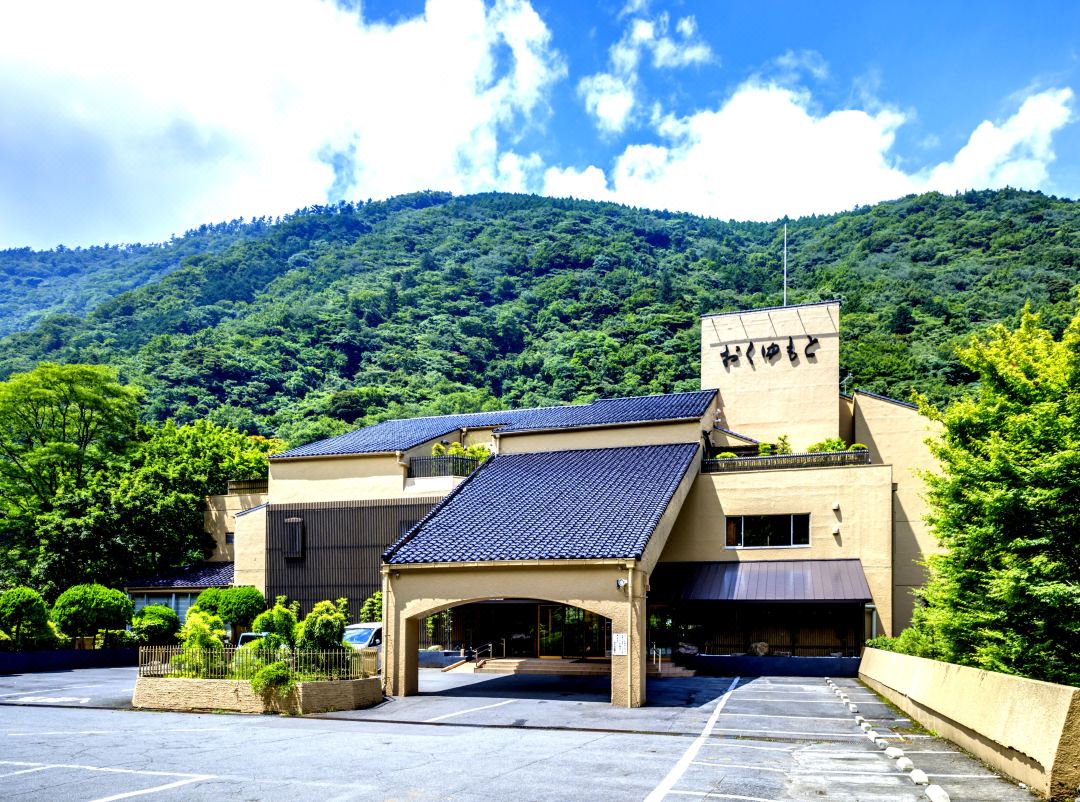

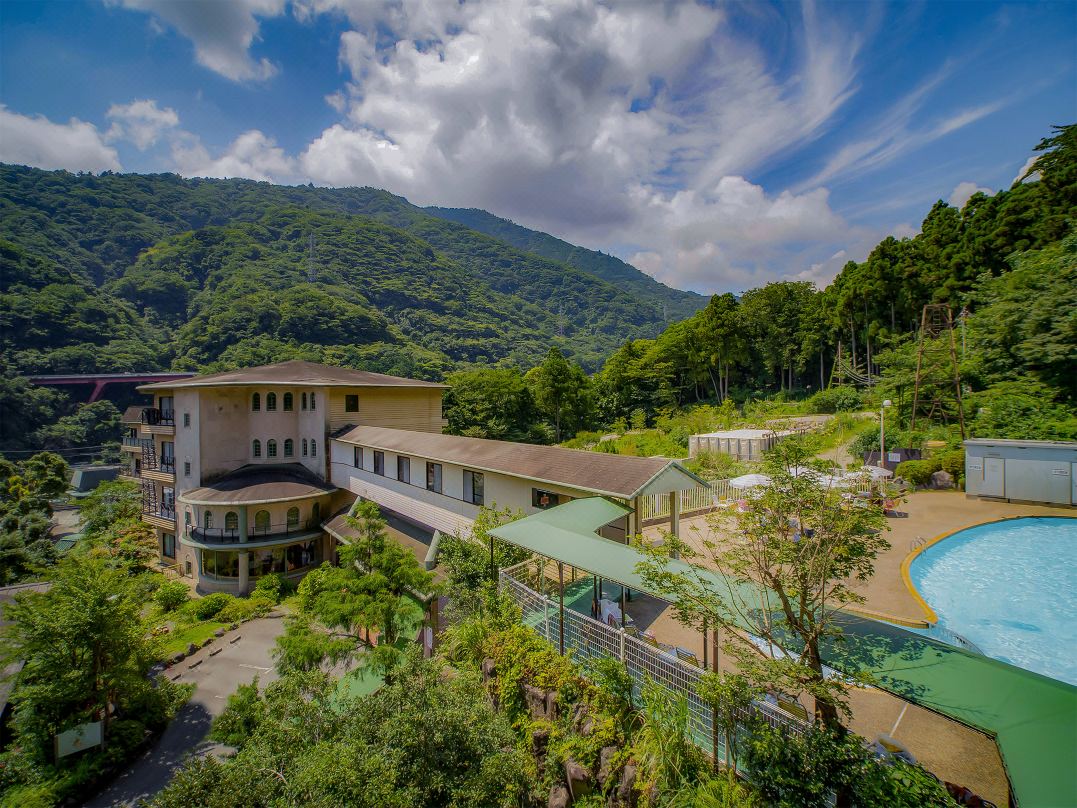



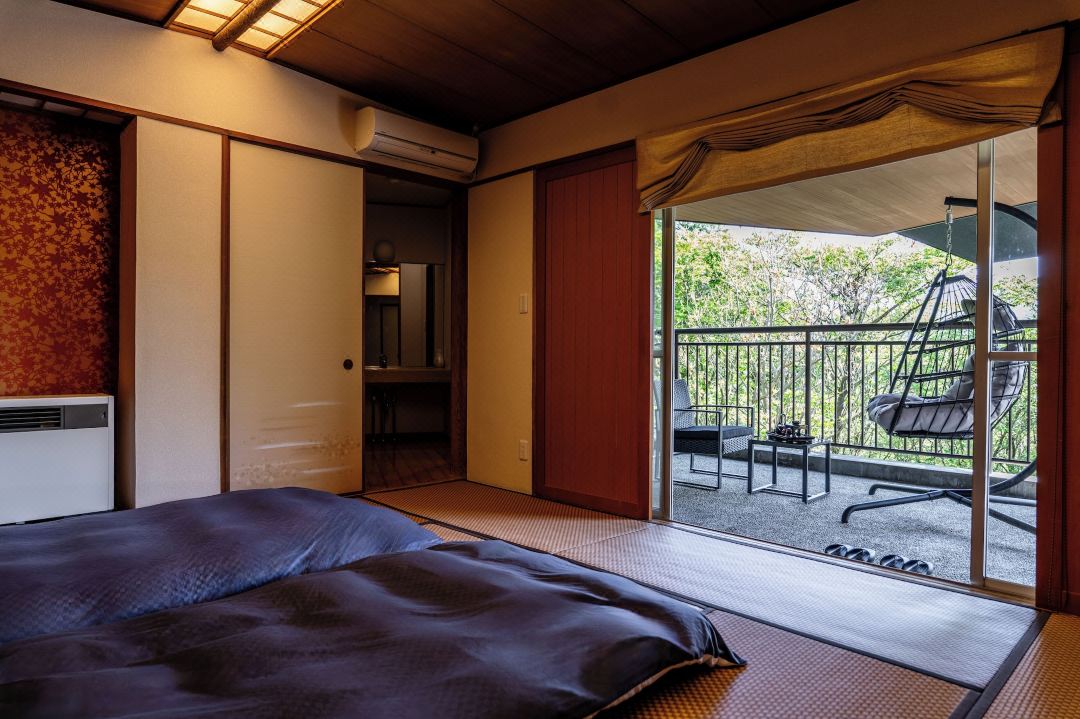

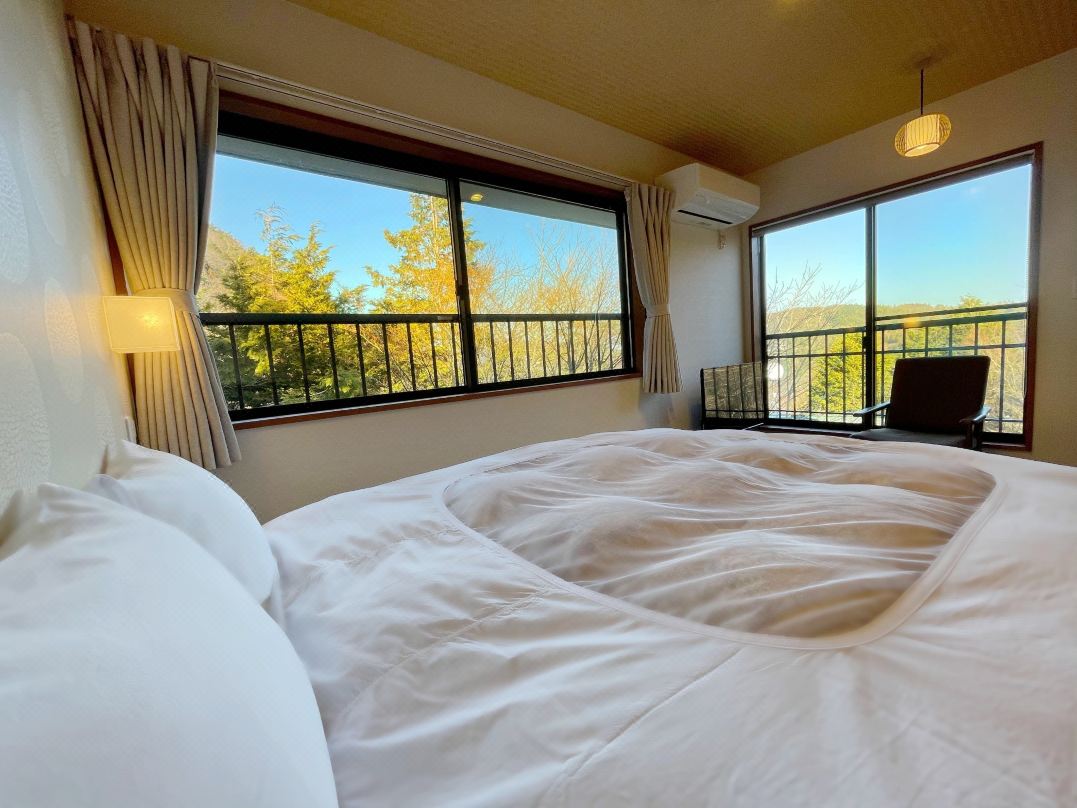
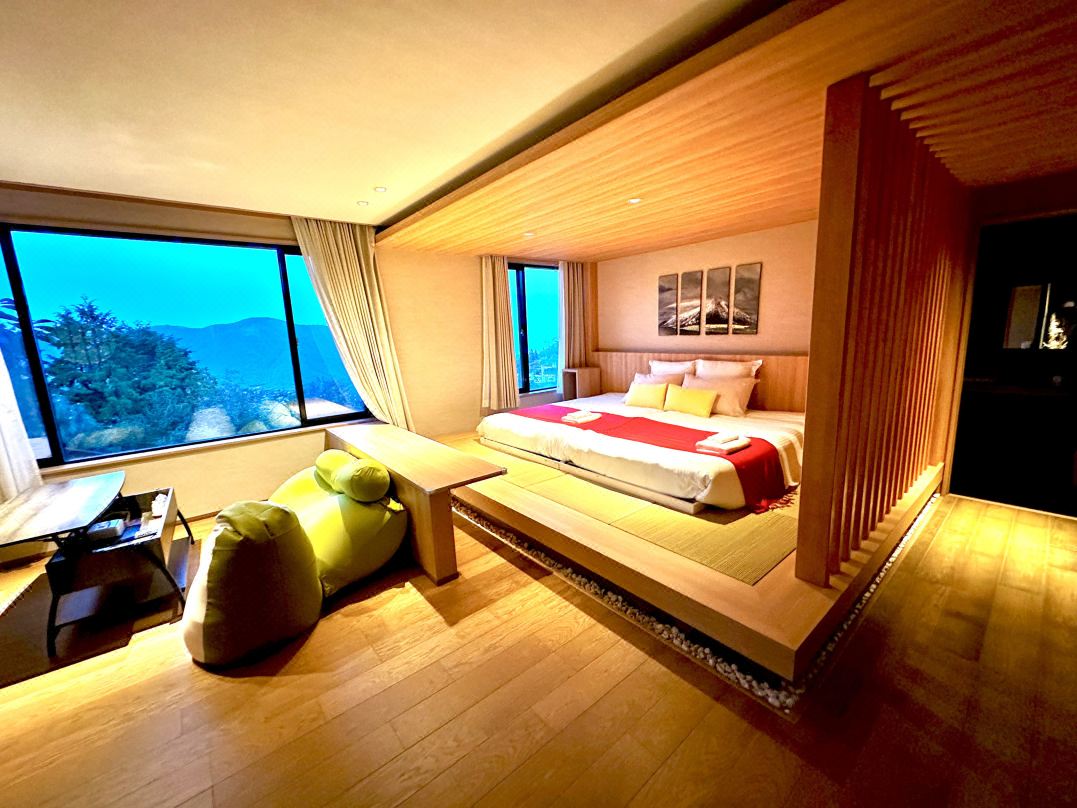








































![[Reopening in March 2026] Ikoma Sanjo Amusement Park Park, 45 minutes from Osaka , with free admission](https://resources.matcha-jp.com/resize/720x2000/2024/08/28-194409.webp)
![[Gunma] 5 recommended gourmet foods at Kawaba Denen Plaza Roadside Station!](https://resources.matcha-jp.com/resize/720x2000/2025/02/26-225970.webp)
![[Kanazawa] Enjoy the world of gold leaf to the fullest in the city with the highest production volume in Japan](https://resources.matcha-jp.com/resize/720x2000/2025/11/12-249564.webp)
![[2026] Family Winter Trip to Suzuka Circuit! – For Both Day trips and Overnight Stays!](https://resources.matcha-jp.com/resize/720x2000/2025/12/26-254097.webp)
